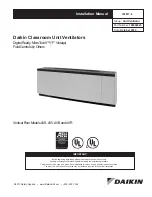
Notes on the electrical installation
Use only cables that are designed for the supply voltage
for which they will be used. The length and cross sec-
tion as well as any contact resistance may increase
voltage losses. The power rating of each unit must
also be considered. A skilled qualified electrician has to
select the correct cable types and sizes. This job must
only be carried out by specialist electrical companies.
For the electrical connection comply with any appli-
cable regulations and follow the code of good
practice. Be sure to comply with the applicable
guidelines for working on electrical and electronic
equipment as well as with any applicabe local regu-
lations.
The connection data can be found on the rating
plate or in the wiring diagrams.
Protect any connections from physical damage.
Feed cables through the cable glands on the ventila-
tion unit.
Ensure that the unit can be de-energised (all
phases) for maintenance such that no voltage is
present. This requires separators (e.g. fuses or
RCBOs); the distance between contacts should be
at least 3 mm.
For units without integral controls from TROX follow
the instructions of the controls provider.
Personnel:
Skilled qualified electrician
DANGER!
Danger of electric shock! Do not touch any live com-
ponents! Electrical equipment carries a dangerous
electrical voltage.
–
Only skilled qualified electricians are allowed to
work on the electrical system.
–
Switch off the power supply before working on
any electrical equipment.
①
Fig. 22: Mains cable
1.
Connect the supply voltage of the device to the
connecting cable ( Fig. 22 /1).
F3
F2
F1
①
②
③
④
Fig. 23: Electrical connection area for wiring by others
1
Cable glands
2
Terminal area for connections by others
3
230 V connection area
4
Device fuses F1, F2, F3 (fuses according to label-
ling)
2.
DANGER!
Risk to life from electrical voltage!
The 230 V connection area ( Fig. 23 /3) may
not be opened, it is used for the internal elec-
trical wiring and may only be opened by TROX
Service personnel.
Connect the supply voltage to the connecting
cable leading out of the device.
Insert the on-site installation into the device via
the cable penetrations ( Fig. 23 /1) and connect to
the corresponding terminals Fig. 23 (/2); see the
following information.
Note:
Provide sufficient cable reserve for connec-
tion (loop approx. 35 cm (between Fig. 23 /1) and
Installation
Making electrical connections
Decentralised ventilation units SCHOOLAIR-S-HV
22
















































